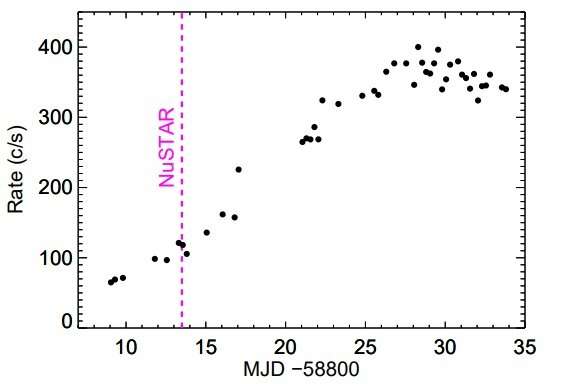April 15, 2020 report
Major outburst and X-ray pulsations detected from RX J0209.6−7427

An international team of astronomers has identified a major outburst and X-ray pulsation from an X-ray binary system known as RX J0209.6−7427. The detection, detailed in a paper published April 6 on the arXiv pre-print server, could shed more light on the nature of this source.
Generally, X-ray binaries are composed of a normal star or a white dwarf transferring mass onto a compact neutron star or a black hole. Based on the mass of the companion star, astronomers divide them into low-mass X-ray binaries (LMXB) and high-mass X-ray binaries (HMXB).
Of special interest are Be/X-ray binaries (BeXRBs), a subclass of HMXBs in which the optical star is a dwarf, subgiant or giant OBe star. Studying X-ray outbursts from BeXRBs could be essential in order to improve our understanding of the nature of X-ray binaries and their behavior.
Located in the outer wing of the Small Magellanic Cloud (SMC), RX J0209.6−7427 is a BeXRB first detected by the ROSAT satellite. The source exhibited two luminous outbursts, in March and November 1993, with measured luminosity at a level of about 100 undecillion erg/s.
Now, a group of astronomers led by Georgios Vasilopoulos of Yale University reports the detection of another significant outburst from RX J0209.6−7427 using the Monitor of All-sky X-ray Image (MAXI) instrument on the International Space Station (ISS). Moreover, the researchers conducted follow-up observations of this outburst with the Neutron Star Interior Composition Explorer (NICER) on ISS, the Nuclear Spectroscopic Telescope Array (NuSTAR) and Fermi spacecraft, which led to the discovery of X-ray pulsations from the system.
"In this paper, we present the first results of the X-ray monitoring of the system during its 2019 outburst. (...) We present the timing and spectral analysis that resulted in the discovery of coherent pulsations and characterization of its broadband X-ray spectrum from NuSTAR and NICER data," the paper reads.
The outburst started on November 20, 2019, when when MAXI identified an uncatalogued X-ray transient source. Afterward, follow-up observations of this event commenced using NICER, NuSTAR and Fermi.
During the November 2019 outburst, the maximum X-ray luminosity of RX J0209.6−7427 reached 2.0 duodecillion erg/s, and NICER detected X-ray pulsations with a period of 9.3 seconds. Therefore, the system temporarily became a pulsating ultra-luminous X-ray source (PULX).
The high luminosity of RX J0209.6−7427 measured during the latest outburst suggests that it might be the brightest BeXRB ever observed in the SMC.
However, the astronomers noted that despite the super-Eddington luminosity of RX J0209.6−7427, the neutron star in the system appears to have only a moderate magnetic field strength. The researchers found that the surface magnetic field of the neutron star is at a level of approximately 3.0 trillion G and its orbital period is likely greater than 50 days.
More information: The 2019 super-Eddington outburst of RX J0209.6-7427: Detection of pulsations and constraints on the magnetic field strength, arXiv:2004.03022 [astro-ph.HE] arxiv.org/abs/2004.03022
© 2020 Science X Network





















